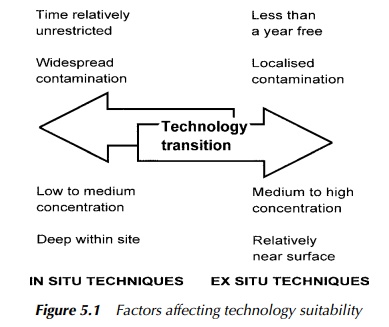Chapter: Environmental Biotechnology: Contaminated Land and Bioremediation
Biotechnology Selection
Biotechnology Selection
Although the primary focus of remediation methods commonly falls on technolo-gies dependent on a relatively high engineering component, there is one purely biological treatment option which can be a very effective means of clean-up. Known variously as ‘natural attenuation’, ‘passive remediation’, ‘bioattenuation’ or ‘intrinsic remediation’, it is appropriate for sites where the contamination does not currently represent a clear danger to human health or the environment. Though it is not an engineered solution, neither is it a ‘do nothing’ approach as is some-times stated, since it is not an exercise in ignoring the problem, but a reasoned decision on the basis of the necessary site investigations, to allow nature to take its course. The approach works with natural cycles and the pre-existing indige-nous microbial community to bring about the required treatment. The need for a good initial survey and risk assessment is clear, and typically a comprehensive monitoring programme is established to keep a check on progress.
The effectiveness of natural attenuation has been demonstrated by 20 years or more of research in the USA, which gave rise to the ‘Part 503 Rule’. Issued in February 1993, the Clean Water Act, specifically the part of it called Title 40 of theCode of Federal Regulations, Part 503 – The Standards for the Use or Disposal of Sewage Sludge, which is commonly referred to as the ‘Part 503 Rule’ or evensimply ‘Part 503’, sets out benchmark limits for the USA.
Typical European regulations follow a precautionary limits model, at times referred to as the ‘no net gain or degradation’ approach, meaning that there should be no overall accumulation of contaminants in the soil, nor any degradation of the soil quality, compared with original levels.
Part 503 is based on risk assessment of selected key pollutants which pose a threat to humans, other animals or plants, making evaluations of a number of different possible pathways, from a direct, ‘single incident’ scenario, to a lifetime of possible exposure via bioaccumulation. The standard which is set as a result is based on the lowest concentration which was deemed to present anacceptable risk.
In this way, higher heavy metal concentrations and cumulative loading rates are permitted than would be allowed under the Europe model, since the ability of soil to lock them up effectively indefinitely has been demonstrated by extensive research. Accordingly US legislation is based on the principle that even if the background level of a given heavy metal species increases over time, its migra-tion or availability for uptake by plants or animals would be precluded by the combined action of the resident microbes and other general soil characteristics. In many ways this has strong echoes of the soil modification of contaminant effect previously discussed.
The engineered solution
If natural attenuation is not appropriate, then some form of engineered response is required, the selection of which will depend on a number of interlinked factors. Thus, the type and concentration of the contamination, its scale and extent, the level of risk it poses to human health or the environment, the intended eventual site use, the time available for remediation, available space and resources and any site-specific issues, all influence this decision. Many of the key issues have already been discussed and the earlier Figure 5.1 sets out the factors governing technology transition between the in situ and ex situ techniques.

Related Topics